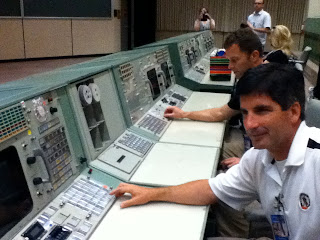 The night before, the "tweeps" who were around met at Frenchies. Frenchies is a restaurant where all the crews come and eat. You can see some of the space memorabilia on the walls.
The night before, the "tweeps" who were around met at Frenchies. Frenchies is a restaurant where all the crews come and eat. You can see some of the space memorabilia on the walls.The brown-haired gentleman on the far right of this picture in the darker blue shirt is Mike Grabois. He was one of the NASA instructors who took the time to come out and meet with us. He also worked with us later at JSC.
The gentleman standing is Charlie Justiz. He was a NASA trainer for over 25 years. The woman sitting to his left is his wife, Dayna Steele. She was one of the "tweeps" and they live in Clear Lake, TX.
We each introduced ourselves with the usual information - where we live, what we do for a living, and our connection to/reasons why we love the space program.

Elissa talked about living in Buffalo, New York, and works as the International Baccalaureate Diploma Program Coordinator at City Honors School. It was said that we had been fortunate enough to see three launches: STS-72 from the NASA Causeway; STS-90 from the press center; and STS-109 from the press center.

Bill talked about how he is finishing his dissertation for his Ph.D. in aerospace engineering and works for Moog.
 He also mentioned our special connection to the STS-90 crew (see below).
He also mentioned our special connection to the STS-90 crew (see below).(Side note: our waitress heard us say we were from Buffalo and came over to tell us that she was born there and her sister lives in Buffalo still. In fact, we found out she lives ON OUR STREET!)
We started the next morning with the breakfast of champions - waffles in the shape of the great state of Texas!

The main sign at JSC welcomed our group.
A sign taped to the door of the Gilruth Center at Johnson Space Center told us we were in the right place.

This large sign greeted us once we were inside. (At the end of our excellent adventure, the JSC Tweetup staff had us all sign this poster.) Here's Bill holding the sign.

Each of us were given badges (the pins were ours - mementos of three launches we've seen) and NASATweetup Lanyards.

Each participant was given a bag of "NASA Goodies" that included a program of our activities for the day - the back page listed the participating "tweeps."
We are the top two listed on the right hand side.

We were split into two groups of 15 each - Red and Blue. Our group, the Red Group, went to the SIM first.

History is everywhere in the buildings at JSC. Here are pictures of the Apollo 11 crew (the 42nd anniversary was the day after our visit - July 20).

Ed Gibson, a native of Kenmore, NY (center of photo) flew on the last Skylab mission in 1973.


A picture of all three Skylab missions.
We couldn't NOT take a picture of the STS-90 crew. Jim Pawelczyk, the only shuttle astronaut from Erie County, NY (pictured far left), was a payload specialist on this mission.
We were the only Western New York "press" that covered his launch.
A year later, we traveled to Poland with Jim and two other crew members as guests of state. Jim flew a Polish flag on the shuttle and returned it to the Polish President as a run up to Poland's entry into NATO and in celebration of their May 1st Constitution Day ceremonies.
American Airlines Pilot & Lockport, NY resident Ron Franco (@chariot401); Houstontonian and local rock radio DJ icon, Dayna Steele (@daynasteele); Bill (@buffalobill1); and Elissa (@elissabflo) were the first group to go.

This white board was in the control room for the Motion-based Shuttle SIM. On it is the plan for the last time the STS-135 crew used the SIM before they headed to KSC for their launch.

Here's an article about the last time the crew of STS-135 used the Motion-based Shuttle SIM on July 1, 2011. They left for KSC and their launch after that.














































